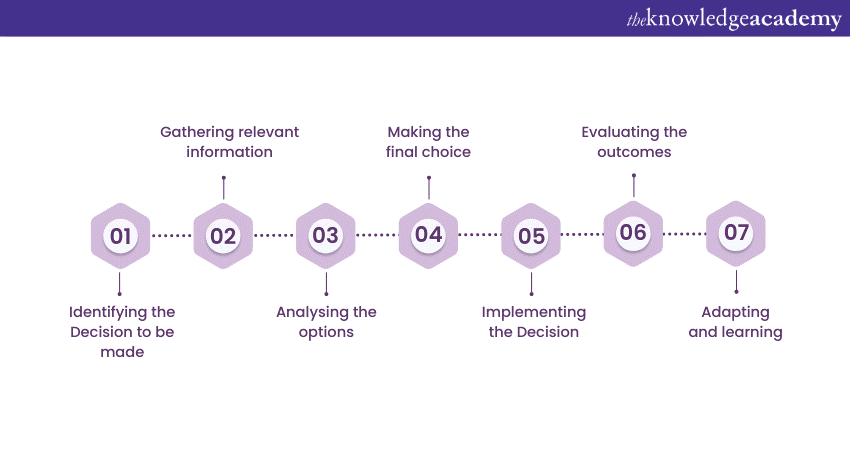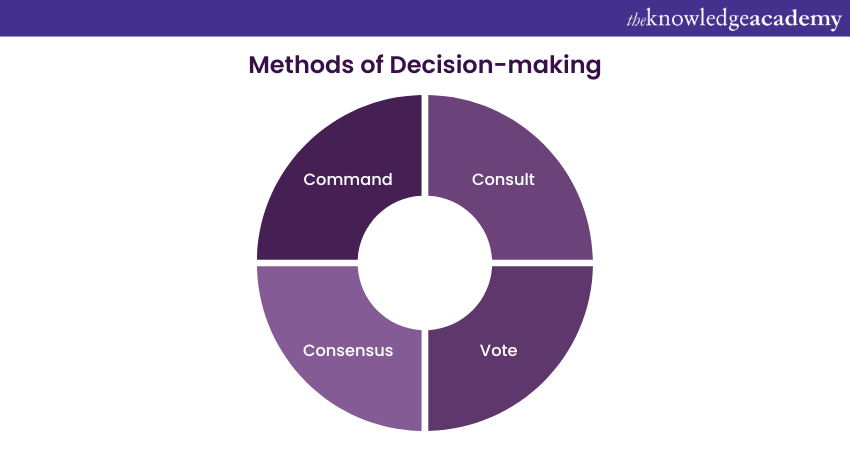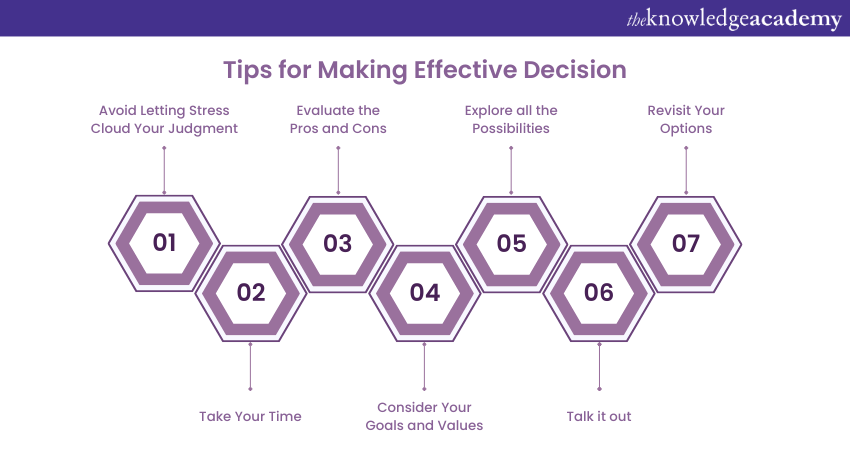We may not have the course you’re looking for. If you enquire or give us a call on + 1-866 272 8822 and speak to our training experts, we may still be able to help with your training requirements.
Training Outcomes Within Your Budget!
We ensure quality, budget-alignment, and timely delivery by our expert instructors.

We all have to make complex Decisions daily, ranging from simple choices like what to have for breakfast to more significant life-altering ones. Decision-making can often be overwhelming; however, with the right approach and understanding – it becomes a more manageable process. Want to know how? In this blog, you will learn all you need to know about How to Make a Decision, providing valuable insights and techniques to aid readers in making better choices.
Table of Contents
1) What is Decision-making?
2) The Decision-making Process
3) Methods of Decision-making
4) Tips for Making Effective Decisions
5) What can Prevent Effective Decision-making?
6) Conclusion
What is Decision-making?
Decision-making is the process of choosing between possible solutions to a problem. It is a skill that involves collecting information, weighing pros and cons, and reviewing alternative solutions. Decision-making can be done by individuals or groups and can be influenced by various factors, such as intuition, reasoning, emotions, values, preferences, and biases.
The Decision-making Process
Now it’s time to learn How to Make a Decision. Follow these steps to learn about the entire process:

1) Identifying the Decision to be made
The road to making decisions begins by first acknowledging the need for a decision. This consciousness usually comes from issues needing resolutions, possibilities to be explored, or objectives requiring concentrated actions. Not recognising this necessity can lead to overlooked chances or unsolved obstacles.
Skilled Decision-makers excel at promptly recognising when decisions are required. They proactively search for circumstances that demand focus and face obstacles directly instead of avoiding them. This first phase is essential, as it kickstarts the entire Decision-making process and fuels development and advancement.
2) Gathering Relevant Information
Once a Decision is recognised, the next imperative step involves gathering relevant information. This phase is akin to assembling building blocks upon which the Decision will rest. The quality of the information gathered profoundly influences the subsequent stages of the Decision-making process.
Collecting data from reliable and diverse sources is necessary to gain a comprehensive understanding of the situation. Information may include facts, figures, expert opinions, and historical precedents. Careful research and analysis enable Decision-makers to be well-informed, ensuring that their choices are based on evidence rather than mere intuition.
3) Analysing the Options
After gathering the necessary information, Decision-makers enter the analytical phase, thoroughly assessing the various options available. This systematic strategy enables an in-depth exploration of every option's possible result, advantages, and disadvantages.
Critical thinking is essential during this stage. Decision-makers evaluate the advantages and disadvantages, balancing immediate and long-term effects while considering risks and benefits. This procedure seeks to minimise prejudices, promoting a neutral evaluation of the available options.
4) Making the Final Choice
The culmination of the Decision-making process rests upon making the final choice. This is the point of commitment when all the pieces of information, analysis, and introspection converge to form the selected course of action.
Making Decisions can sometimes be challenging, especially when faced with uncertainty or when choices have significant implications. Decision-makers must trust their judgment, drawing upon the insights gained from the preceding stages. Confidence in the Decision-making process and a belief in one's abilities are vital at this juncture.
5) Implementing the Decision
A Decision without action remains merely a concept. Therefore, implementing the chosen course of action is as crucial as the Decision-making process itself. This stage demands planning, preparation, and execution.
During implementation, Decision-makers need to develop a clear and well-structured strategy. Communicating the Decision effectively to relevant stakeholders and garnering their support can be instrumental in ensuring successful execution.
6) Evaluating the Outcomes
The Decision-making process extends beyond making a choice; it encompasses evaluating the outcomes resulting from the Decision. This evaluation provides valuable insights into the effectiveness of the Decision and its impact on the desired objectives.
Assessing outcomes offers a valuable learning opportunity. Positive outcomes reinforce the validity of the Decision-making process, while negative outcomes provide a chance for reflection and improvement. By analysing the results, Decision-makers can refine their approach and enhance their Decision-making capabilities.
7) Adapting and Learning
The final step in the Decision-making process is an ongoing commitment to adaptability and learning. Life is dynamic, and new challenges and opportunities continuously present themselves. Embracing an open mindset and a willingness to learn from both successes and failures ensure continual development as a Decision-maker.
Adjusting Decision-making strategies based on acquired knowledge and experiences allows individuals to navigate through life's complexities more adeptly. By staying open to feedback and being receptive to change, Decision-makers can confidently face the uncertainties that lie ahead and emerge stronger and wiser.
Empower your Leadership journey with our comprehensive Leadership Training – join today!
Methods of Decision-making
While making decisions, it is important to consider different approaches. Here are four methods of Decision-making in detail:

1) Command
The command method requires making decisions on one's own without any external input. It is frequently utilised in commanding leadership and providing immediate solutions, particularly in urgent situations. This method is effective but comes with greater dangers since only one person, typically a leader or manager, makes the final decision.
2) Consult
The consultation process involves gathering input from various people, but the final decision is made by one individual. While it may be more time-consuming than using the command method, taking this approach enables a wider range of perspectives, leading to decisions with reduced risk. It also promotes feelings of being included, making others feel part of the process.
3) Vote
During the voting process, the group openly debates options before taking a democratic vote. Every participant decides to support or oppose the suggested solution. Voting allows for quick Decision-making and is commonly employed when individuals speak on behalf of broader sets of workers, ensuring an open and effective process for making decisions.
4) Consensus
The consensus method involves extensive group discussions where all parties share their views until they reach a unified decision. While time-consuming, often requiring multiple meetings, this approach minimises risk, as it ensures broad agreement and consideration of diverse perspectives before finalising the decision.
Tips for Making Effective Decision
Learning how to Make a Decision is crucial for achieving goals and solving problems. Let’s explore some effective tips for improving your Decision-making:

1) Avoid Letting Stress Cloud Your Judgment: Stress can easily cloud your judgment and lead to poor Decision-making. Try to stay calm and composed when making important Decisions.
2) Take Your Time: Don’t rush into Making a Decision. Take some time to gather information, weigh the pros and cons, and consider all the possibilities.
3) Evaluate the Pros and Cons: Make a list of the advantages and disadvantages of each option. This will help you evaluate the potential outcomes of each Decision.
4) Consider your Goals and Values: Ensure that each Decision aligns with your personal and professional goals and values. This will help you make a Decision that is in line with your priorities.
5) Explore all the Possibilities: Don’t limit yourself to just one option. Consider all the possibilities and evaluate each one based on its merits.
6) Talk it out: Discussing your options with someone else can help you gain a fresh perspective and identify potential blind spots.
7) Revisit Your Options: Revisit your options and rethink your Decision if necessary. It’s okay to change your mind if new information comes to light.
Sharpen your strategic capabilities with our Decision-Making Training – lead confidently and decisively!
What can Prevent Effective Decision-making?
There are many factors that can prevent effective Decision-making. Let’s discuss some of the common obstacles and how to overcome them:
1) Insufficient and Inaccurate Information: Without enough and correct information, it is hard to identify the problem, generate alternatives, and assess the consequences of each Decision. Information gaps can arise from inadequate research, unreliable sources, or incomplete data.
2) Misunderstanding the Problem: Sometimes, the problem that needs to be solved is not clearly stated or understood. This can result from a lack of clarity, focus, or agreement on the problem statement. Poor problem definition can lead to irrelevant or ineffective Decisions.
3) Neglecting Risks: Every Decision involves some degree of uncertainty and risk. Neglecting to consider the possible risks and their likelihood and impact can result in unexpected and undesirable consequences. Risk assessment can help to identify, measure, and reduce the potential threats and opportunities associated with each Decision.
4) Personal Bias: Bias is the tendency to favour or reject certain information or options based on personal preferences, emotions, beliefs, or stereotypes. Bias can skew the perception, interpretation, and evaluation of information and options and lead to irrational or illogical Decisions.
5) Lack of Communication: Communication is essential for effective Decision-making, especially when multiple stakeholders are involved. Lack of communication can result in a lack of input, feedback, collaboration, or consensus among the Decision-makers. Communication can help share information, perspectives, opinions, and concerns and reach a common understanding and agreement on the best course of action.
Conclusion
We hope that this blog provided you with an understanding of How to Make a Decision, overcome biases, and harness the power of intuition. Remember that Making Decisions is an integral part of life, and by following the right framework, we can improve the quality of our choices. Every Decision is an opportunity to grow and learn.
Unlock the power of innovation with our Creative and Analytical Thinking Training – sign up now
Frequently Asked Questions

Being proactive in Decision-making aids Project Managers in effectively handling uncertainties, resource allocation, and challenges. Assessing different options, considering potential hazards, and implementing crucial factors for success enhance the chances of achieving project goals.

Various tools and frameworks are available that can make Decision-making easier. Mind Maps record brainstormed thoughts and ideas, while Six Thinking Hats direct group conversations. The Reframing Matrix encourages a positive perspective on challenges and a Fishbone Diagram reveals underlying reasons and possible answers.

The Knowledge Academy offers various Leadership Courses, including Leadership skills, Business Development and many more. These courses cater to different skill levels, providing comprehensive insights into Leadership skills in general.
Our Leadership Blogs cover a range of topics related to Leadership, offering valuable resources, best practices, and industry insights. Whether you are a beginner or looking to advance your Leadership skills, The Knowledge Academy's diverse courses and informative blogs have you covered.

The Knowledge Academy’s Knowledge Pass, a prepaid voucher, adds another layer of flexibility, allowing course bookings over a 12-month period. Join us on a journey where education knows no bounds.

The Knowledge Academy takes global learning to new heights, offering over 30,000 online courses across 490+ locations in 220 countries. This expansive reach ensures accessibility and convenience for learners worldwide.
Alongside our diverse Online Course Catalogue, encompassing 17 major categories, we go the extra mile by providing a plethora of free educational Online Resources like News updates, blogs, videos, webinars, and interview questions. By tailoring learning experiences further, professionals can maximise value with customisable Course Bundles of TKA.
Upcoming Business Skills Resources Batches & Dates
Date
 Successful People Management and Team Leadership
Successful People Management and Team Leadership
Fri 10th Jan 2025
Fri 14th Feb 2025
Fri 11th Apr 2025
Fri 23rd May 2025
Fri 8th Aug 2025
Fri 26th Sep 2025
Fri 21st Nov 2025







 Top Rated Course
Top Rated Course



 If you wish to make any changes to your course, please
If you wish to make any changes to your course, please


